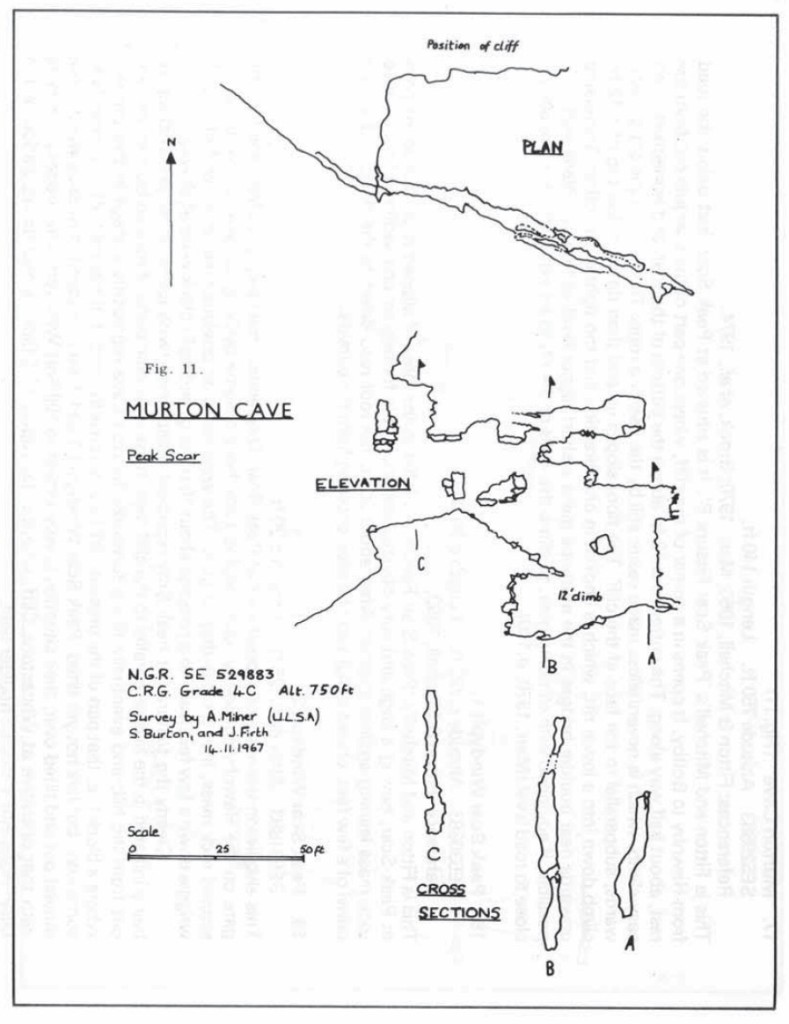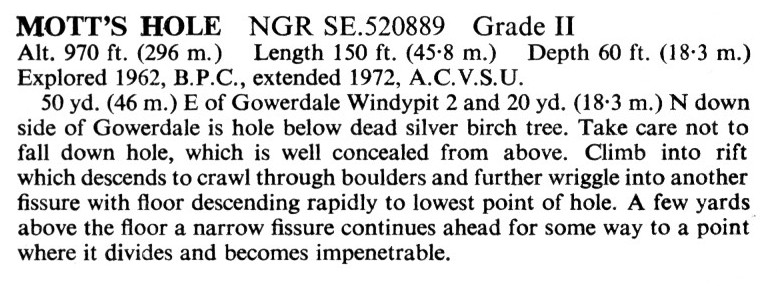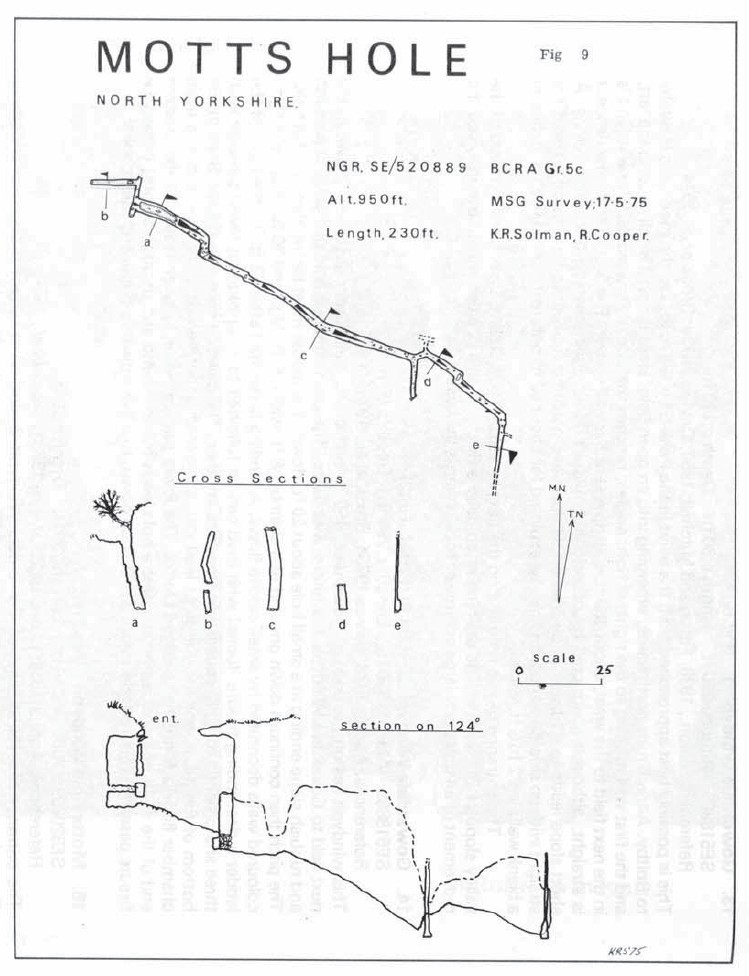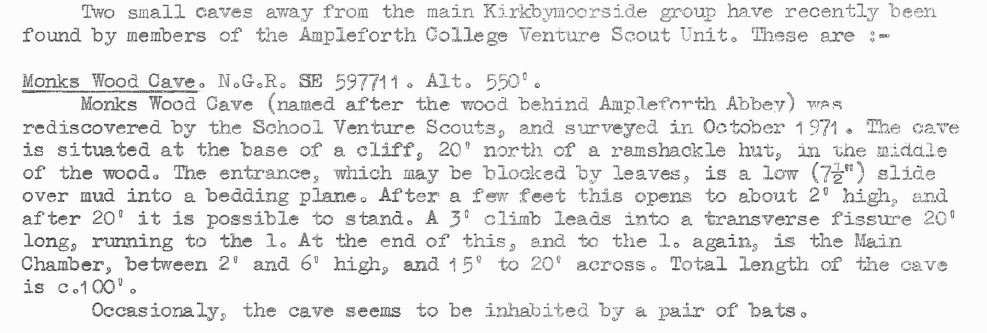Newgate Bank Rift
A rift somewhere in the region of three feet wide and ten feet deep was accidentally discovered and subsequently filled during road repairs during late 1974.
BCRA Transactions – Vol.3 No.2 – The North Yorkshire Windypits (1976)

Moorland Caver (2003)
NGR: SE 592883
Altitude: 230m
Length: 42m
Grade: II
Entertainment Value: II
This is a traditional climbers route down to the bottom of Peak Scar.
The entrance it self is 4m up from the bottom and runs sub-parallel to the cliff. A short climb up and 3m down drops into a lower rift which is choked
in one direction and too tight at the other, climbing up into boulders at the same level as the entrance is a short bit ending in a blank wall.
Further up, various high level routes exist eventually exiting at the top of the cliff.
BCRA Transactions – Vol.3 No.2 – The North Yorkshire Windypits (1976)

Moorland Caver (2003)
NGR:SE 518889
Altitude: 290m
Length: 70 m
Depth: 21 m
Access: Permission to descend is not granted
Grade: II
Entertainment Value: III
Motts can be rather an awkward hole to find and is best approached from
Gowerdale II (q.v). From Gowerdale II follow the fence East for about fifty paces, then head North down slope through trees for about twenty
paces. Motts lies in a clearing with a tree growing from the entrance.
The entrance is free climbable with care, however the safest option is to ladder the 7m entrance, best belayed to a convenient overhanging branch.
Follow the descending slope down to the eastern corner of the rift where a thrutch through boulders leads into the main part of the rift.
Good going along the rift, past narrow branch fissures (blind).
The main rift ends in a rocky area, which can be passed on two levels both of which peter out in a narrow continuation to the right.
Back at the foot of the entrance pitch it is possible to enter a further, short length of passage at the western end of the rift, an L shaped fissure, which chokes after circa 3m. This section can be explored on two levels.
Tackle:
Entrance: 7m ladder, spreader & sling; belay to overhanging branch (optional).
History
Windypit VI was initially discovered in 1947 by Chadwick of the Y.R.C. The hole was rediscovered in circa 1962 by the Bradford Pothole Club who named it Motts Hole.
Pushed to a definite conclusion by A.C.V.S.U. in 1972.
Yorkshire Ramblers Club – Journal 7 (1952)
In 1947, Chadwick went 30 ft. down VI, a crack, 65 yards E. of IV, and 30 ft. down the slope of Gowerdale.
Northern Caves Volume 5 (1974)

BCRA Transactions – Vol.3 No.2 – The North Yorkshire Windypits (1976)



Moorland Caver (2003)
NGR: SE 597791
Altitude:170m
Length:33m
Access: Ampleforth College
Entrance at the foot of a cliff near a dilapidated hut in Monks Wood
Flat out crawl in wide passage leads to climb into two chambers, from the second chamber, a passage leads off with a vocal link to the surface.

Moldywarps Speleological Group – Journal 6 (1973)

Northern Caves Volume 5 (1974)

BCRA Transactions – Vol.3 No.2 – The North Yorkshire Windypits (1976)

Moorland Caver (2003)
Alt: 230m
Access: No known restrictions
Peak Scar represents some of North Yorkshire’s finest climbs, its honey coloured rock is both strong and grippy. The weathered limestone cliff has all the good plus points for climbing. It is almost on the side of the road, it’s easily roped and has an abundance of good handholds. On a mild summers evening with a warm orange sun lighting up the cliff you have to ask your self “where else would I rather be? “. Why, Under ground of course!!
Peak Scar has three known caves and a myriad of little crawls amongst jumbled blocks, the caves aren’t particular big but when the warm orange sun is setting, what else is there to do. Go on, do some exploring then go to the pub.
PEAK SCAR WINDYPIT 1.
NGR: SE 530883
Length: 10m
This doesn’t fit in the term of windypit, as it is merely a slumped slab rock with a void underneath. However it does deserve a mention. It lies in a mass of fallen blocks beside the path, the entrance is quite large and rift like, continuing for 6m and ending after a short crawl where day light can be seen.
PEAK SCAR WINDYPIT 2.
NGR: SE 531883
Length: 7m
This is also amongst slumped blocks, beside the path. Doubling back into damp fern strewn gully to entrance at end. Squeeze down into small rift ending in blank walls.
BCRA Transactions – Vol.3 No.2 – The North Yorkshire Windypits (1976)


Moorland Caver (2003)
NGR: SE 505867
Altitude: 320m
Length:15m
Depth:11m
Access: No known restrictions
Grade: II
Entertainment Value: I
Entrance is a small hole about 12m down from Boulby scar, in top of slumped bank. Vegetation completely obscures the entrance for most of the year, making it extremely difficult to find.
Entrance pitch of 3m, best laddered from tree, lands in Chamber 1 followed by 4.5m pitch into chamber 2 and 2a. From the opposite end of chamber 1 is a 3m climbable route into chamber 3. All chambers are in a jumble of collapsed blocks and are best laddered as one due to the loose nature of the walls.
Tackle:
8m ladder, 4m belay, 15m lifeline.
History
Explored by Y.U.R.T. in 1968 and called Hillfort after the assumed Iron Age Hill Fort on the bank top. The ramp and ditch features of the Hill Fort were later found to be slump features associated with slope failure.
Northern Caves Volume 5 (1974)


BCRA Transactions – Vol.3 No.2 – The North Yorkshire Windypits (1976)
